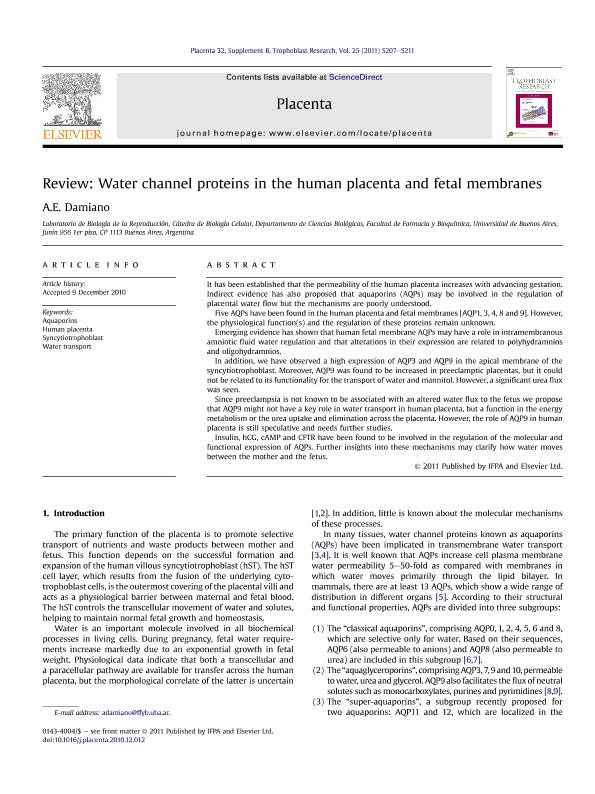Mostrar el registro sencillo del ítem
dc.contributor.author
Damiano, Alicia Ermelinda

dc.date.available
2017-02-10T20:37:01Z
dc.date.issued
2011-04
dc.identifier.citation
Damiano, Alicia Ermelinda; Review: Water channel proteins in the human placenta and fetal membranes; Elsevier; Placenta; 32; Supp 2; 4-2011; s207-s211
dc.identifier.issn
0143-4004
dc.identifier.uri
http://hdl.handle.net/11336/12889
dc.description.abstract
It has been established that the permeability of the human placenta increases with advancing gestation. Indirect evidence has also proposed that aquaporins (AQPs) may be involved in the regulation of placental water flow but the mechanisms are poorly understood. Five AQPs have been found in the human placenta and fetal membranes [AQP1, 3, 4, 8 and 9]. However, the physiological function(s) and the regulation of these proteins remain unknown. Emerging evidence has shown that human fetal membrane AQPs may have a role in intramembranous amniotic fluid water regulation and that alterations in their expression are related to polyhydramnios and oligohydramnios. In addition, we have observed a high expression of AQP3 and AQP9 in the apical membrane of the syncytiotrophoblast. Moreover, AQP9 was found to be increased in preeclamptic placentas, but it could not be related to its functionality for the transport of water and mannitol. However, a significant urea flux was seen. Since preeclampsia is not known to be associated with an altered water flux to the fetus we propose that AQP9 might not have a key role in water transport in human placenta, but a function in the energy metabolism or the urea uptake and elimination across the placenta. However, the role of AQP9 in human placenta is still speculative and needs further studies. Insulin, hCG, cAMP and CFTR have been found to be involved in the regulation of the molecular and functional expression of AQPs. Further insights into these mechanisms may clarify how water moves between the mother and the fetus.
dc.format
application/pdf
dc.language.iso
eng
dc.publisher
Elsevier

dc.rights
info:eu-repo/semantics/openAccess
dc.rights.uri
https://creativecommons.org/licenses/by-nc-nd/2.5/ar/
dc.subject
Aquaporins
dc.subject
Human Placenta
dc.subject
Syncytiotrophoblast
dc.subject
Water Transport
dc.subject.classification
Fisiología

dc.subject.classification
Medicina Básica

dc.subject.classification
CIENCIAS MÉDICAS Y DE LA SALUD

dc.title
Review: Water channel proteins in the human placenta and fetal membranes
dc.type
info:eu-repo/semantics/article
dc.type
info:ar-repo/semantics/artículo
dc.type
info:eu-repo/semantics/publishedVersion
dc.date.updated
2017-02-09T18:23:08Z
dc.journal.volume
32
dc.journal.number
Supp 2
dc.journal.pagination
s207-s211
dc.journal.pais
Países Bajos

dc.journal.ciudad
Amsterdam
dc.description.fil
Fil: Damiano, Alicia Ermelinda. Universidad de Buenos Aires. Facultad de Farmacia y Bioquímica. Departamento de Ciencias Biológicas; Argentina. Consejo Nacional de Investigaciones Científicas y Técnicas. Oficina de Coordinación Administrativa Houssay; Argentina
dc.journal.title
Placenta

dc.relation.alternativeid
info:eu-repo/semantics/altIdentifier/url/http://www.sciencedirect.com/science/article/pii/S014340041000514X
dc.relation.alternativeid
info:eu-repo/semantics/altIdentifier/doi/http://dx.doi.org/10.1016/j.placenta.2010.12.012
Archivos asociados
